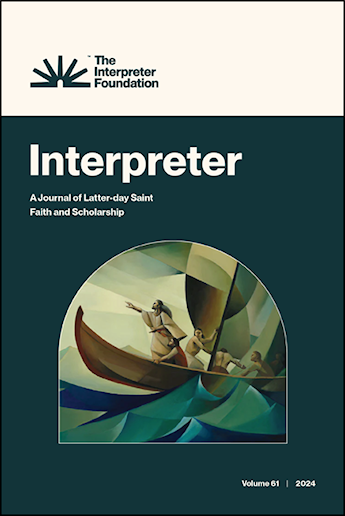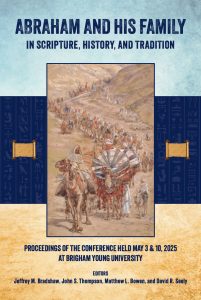Abstract: This paper explores the conclusions that can be drawn from a Mesopotamian origin theory for the Jaredites. The goal is to show that the story of Jared’s daughter in Ether 8 could be a ritual similar to hieros gamos, or sacred marriage, from Mesopotamia. To achieve this, etymologies are given for three names (Jared, Ether, and Akish). These interesting etymologies help substantiate the sacred marriage theory for Ether 8. Finally, a comparison between Ether 3 and Ether 8 show that both illustrate an initiation into the divine. In the former case, it is a righteous initiation into the divine; in the latter, it is an initiation into an idolatrous imitation of the divine.
 Welcome to Interpreter: A Journal of Latter-day Saint Faith and Scholarship, the peer-reviewed journal of The Interpreter Foundation, a nonprofit, independent, educational organization focused on the scriptures of The Church of Jesus Christ of Latter-day Saints. Non-print versions of our journal are available free of charge, with our goal to increase understanding of scripture. Our latest papers can be found below.
Welcome to Interpreter: A Journal of Latter-day Saint Faith and Scholarship, the peer-reviewed journal of The Interpreter Foundation, a nonprofit, independent, educational organization focused on the scriptures of The Church of Jesus Christ of Latter-day Saints. Non-print versions of our journal are available free of charge, with our goal to increase understanding of scripture. Our latest papers can be found below.
Interpreter's Mission Statement →
Read the journal →
Learn more about the Board →
Find out how you can donate →
Contact the Editorial Board →

Church History and Great Britain with the Interpreter Foundation 14-Day Land Tour escorted by Dan Peterson, Kristine Frederickson, and Peter Fagg May 6-19, 2026 This tour will sell out fast so book your reservation now! Go to https://interpreterfoundation.org/study-travel/britain-2026/ for more information |
|
Abraham and His Family in Scripture, History, and Tradition Proceedings of the Conference held May 3 & 10, 2025 at Brigham Young University Sponsored by The Interpreter Foundation, Edited by Jeffrey M. Bradshaw, John S. Thompson, Matthew L. Bowen, & David R. Seely Published by The Interpreter Foundation and Eborn Books For more information, go to https://interpreterfoundation.org/books/abraham-and-his-family/ |
|
Call for Proposals “For a Wise Purpose in Him” Perspectives on the Small Plates of Nephi A Conference on the Small Plates of Nephi in the Book of Mormon May 29-30, 2026 Sponsored byThe Interpreter Foundation Go to https://interpreterfoundation.org/conferences/2026-small-plates-of-nephi/ for more information |
The Islamic Jesus
Review of Mustafa Akyol, The Islamic Jesus: How the King of the Jews Became a Prophet of the Muslims (New York: St. Martin’s Press, 2017). 288 pp., $17.99 (paperback).
Abstract: In his book, The Islamic Jesus, Muslim author Mustafa Akyol paints a portrait of the Qur’an’s Isa (Jesus) and attempts to locate this picture within the landscape of Judeo-Christian biblical scholarship. He is excited to find Islamic Jesus parallels within the Gospels, the Epistle of James, and early non-canonical Christian writings such as the Didache and the Gospel of Thomas. Akyol follows the path of these discoveries to so-called “Jewish Christianity” and postulates that remnants of this Christian movement might have been active in seventh-century Arabia. Ultimately, he writes to encourage Muslims to embrace Jesus as a focal point of much-needed reform within the Islamic world. In my review, I highlight three major themes in Akyol’s book. Each theme represents a topic over which I believe Latter-day Saints can ally with our Muslim neighbors theologically or at least glean helpful learnings from Akyol’s journey of discovery.
Why God Placed Adam and Eve Under Paradoxical Injunctions: A View of the Garden Scene through the Optics of Communication Theory
Abstract: This paper investigates the pragmatic aspect of communication between God and our first parents while in the Garden of Eden—the psychological impact of placing them under contradictory injunctions that result in a situation of “damned if you do and damned if you don’t.” God could not introduce knowledge that, by definition, also involves introducing evil, which is a prerequisite for choice. Instead he issued a paradoxical injunction that placed Adam and Eve in an influence-free decision-making environment with the implied message of “make a decision!” The beguiling influence of Satan provided additional information, a way to escape the paradox. Hence, the paradoxical injunction became an instrument to influence a decision-making process without God having to introduce evil and without having to make an argument in one direction over another.
Death by Chocolate: Considering the Wine Imbibed by the Lamanite Guards
Abstract: This article examines two instances in the Book of Mormon in which captives escape through the negligence of drunken and sleeping guards. It suggests that details about the wine used to intoxicate the Lamanite guards in the city of Gid provide support for a candidate consumable, which, despite the impression the title may give, is not a piece of triple-chocolate cake, but is in fact an alcoholic drink brewed using cacao. The article briefly reviews the history of chocolate/cacao as it touches upon liberating captives from bondage and the use of deceptive practices in times of warfare. It briefly discusses the possibility of a Lamanite intelligence network driving some of the political events during the Lamanite wars narrated in the book of Alma.
Nameless to New Name: Namelessness in the Narrative of the Anti-Nephi-Lehies, or the People of Ammon
Abstract: A narrator may choose to provide or withhold the name of a character for many reasons. This article hypothesizes that Mormon intentionally omitted the name of two key characters, a Lamanite king and queen. Both feature in his narration of the mission to the Lamanites and the miraculous conversion it inspires, as recounted in the book of Alma. While it is not possible to know exactly what information Mormon and other record keepers of the Book of Mormon had or preserved, it is at least plausible that Mormon might have intentionally omitted the name of these two Lamanites. Namelessness invites the reader to encounter and re-encounter the gospel in a story simultaneously historic and symbolic, at once particular and universal. The intentional absence of these names emphasizes, instead, the new name the converted Lamanites would take upon themselves and points the reader to the name of Jesus Christ.
Evidence for Well-Structured Persuasive and Argumentative Essays in the Book of Mormon
Review of Edward K. Watson, Verifiable Evidence for the Book of Mormon: Proof of a Deliberate Design Within a Dictated-from-Imagination Book (Springville, UT: Brainy Press, 2022). 252 pp.; $32.95 (hardcover).
Abstract: Edward K. Watson provides a new twist in the textual evidence for the authenticity of the Book of Mormon. Drawing upon his expertise in working with argumentative and persuasive essays (collectively known as “structured essays”) and applying modern scholarship to the requirements for sound argumentation in such essays, Watson seeks to apply objective criteria and scoring methods to evaluate several of the many structured essays in the Book of Mormon. Watson argues that because such essays generally require considerable planning and revision, it would be very unlikely for them to have been created, rather than translated, by Joseph Smith dictating at high speed and without major revisions. While his analysis adds new dimensions to the complexity and depth of the Book of Mormon, I believe that his claims are overstated and not adequately supported, especially when he says that dictating structured essays would be “impossible” for any mortal. Nevertheless, Watson does provide interesting evidence on a long-overlooked aspect of the Book of Mormon that merits consideration.
Why was the Liahona a Sphere? A New Perspective on Its Form and Function
Abstract: A new, simpler design for the Liahona is proposed, which, if correct, makes the reason for two spindles and a hollow-ball shape perfectly obvious. Previous proposed models of the Liahona usually show horizontal, compass-like pointers inside an open-top ball, but our model has vertical spindles protected inside a hollow ball with viewing ports to allow the aligned spindles to be superimposed on a view of the horizon, precisely marking the direction of travel. Lehi’s first use of the Liahona is discussed. Book of Mormon descriptions of the Liahona and how it was used are compared with modern attempts to visualize its design and function. A greater understanding of the Liahona’s two spindles and its surface text may yet be discovered from experimentation with physical models.
Adam Clarke and Isaiah in
the Book of Mormon
Abstract: A recent article alleges that in creating the Book of Mormon, Joseph Smith copied Isaiah passages out of the Bible commentary of Scottish theologian Adam Clarke. The author of the article alleges that while doing so, the Prophet edited those passages based on suggestions from Clarke’s cross references and commentary. This explains the differences between Isaiah in the King James translation and the corresponding Isaiah passages in the Book of Mormon. A careful analysis of the Isaiah verses in the Book of Mormon and Clarke’s commentary shows that this claim is not true.
The Plates of Gardner
Review of Brant A. Gardner, The Plates of Mormon: A Book of Mormon Study Edition, and its companion volume, Engraven Upon Plates, Printed Upon Paper: Textual and Narrative Structures of the Book of Mormon (Salt Lake City: Greg Kofford Books, 2023). Study edition 598 pp.; $34.95 (paperback). Commentary 485 pp.; $24.95 (paperback).
Abstract: This paper addresses the reasons for a recent spurt in Book of Mormon study editions and contextualizes the unique contributions of Brant Gardner’s The Plates of Mormon: A Book of Mormon Study Edition. Unlike other study editions, which cater to the needs of believing Church members, prospective missionaries, or the (secular) scholarly community, Gardner writes that The Plates of Mormon is an attempt to understand the book in terms of the ancient Mesoamerican culture that produced it, something for which he, a trained Mesoamericanist, is uniquely qualified. To do so, he must first peel away the layers superimposed upon its current version by Joseph Smith’s translation for his Early American frontier community. That complicated process is detailed in a companion volume, Engraven Upon Plates, Printed Upon Paper: Textual and Narrative Structures of the Book of Mormon, which receives the bulk of this review’s attention. Gardner’s discoveries and conclusions are briefly rather than comprehensively summarized in this review.
Smooth Words and Slippery Things: Samuel the Lamanite’s Prophetic Use of Hebrew ḥlq
Abstract: Samuel the Lamanite expressly drew on the words of Isaiah (Isaiah 30:10) and possibly Jeremiah (Jeremiah 23:12) with a clever, powerful wordplay on forms of the Hebrew verbal root ḥlq: ḥălāqôt (“flattering words,” literally “smooth things”) and ḥălaqlaqqôt (“slippery [things]”) in Helaman 13:28–36. This wordplay established a genetic relationship between yielding oneself to those who “speak flattering words unto [us]” (Helaman 13:28) and material riches and treasures becoming “slippery that [we] cannot hold them” (Helaman 13:31, 36). This use of smooth/slippery, closely tied to the discussion in the Hebrew Bible of giving heed to false prophets over true prophets, is thus an apt marker of Samuel’s meaning, and perhaps also of his training. Samuel’s pronouncement of this unique curse, linguistically correlated with rejecting prophetic words, described a loss of worldly wealth and vividly depicted the accompanying spiritual desolation of slippery ways and dark places. Mormon and Moroni offered their latter-day readers a way out of the cycle of “slippery” possessions and destruction that befell the Jaredites and the Nephites: Jesus Christ, who showed us how to lay up treasures in heaven. Mormon’s preservation of Samuel’s prophetic wordplay stands as a significant, additional confirmation of the ancient provenance of the text.
Reconciling Evolution by Faith or Framing?
Review of Jamie L. Jensen, Steven L. Peck, Ugo A. Perego, and T. Benjamin Spackman, eds. The Restored Gospel of Jesus Christ and Evolution. Provo, UT: College of Life Sciences, Brigham Young University, 2025. 272 pgs.
Abstract: This review critically evaluates The Restored Gospel of Jesus Christ and Evolution, a multi-author volume that seeks to harmonize evolutionary science with the doctrines and theological framework of The Church of Jesus Christ of Latter-day Saints. While the book offers valuable pedagogical models, personal narratives, and historical context for addressing faith-science tensions, it exhibits notable limitations. Chief among these is an oversimplified distinction between belief and acceptance in scientific discourse, a lack of engagement with legitimate critiques of evolutionary theory, and insufficient resolution of scriptural and theological tensions. Although the collection succeeds in promoting dialogue and reducing conflict among religious students and educators, its rhetorical bias toward scientific consensus and avoidance of unresolved doctrinal issues ultimately weakens its reconciliatory potential. The volume is a meaningful step forward but leaves substantial theological and epistemological work unfinished. The volume’s most commendable aspiration lies in its effort to model epistemological reconciliation—not merely tolerance—between scientific and religious modes of knowing, a theme that could benefit from further theological exploration.
Anachronisms: Accidental Evidence in Book of Mormon Criticisms
Preface
[Editor’s Note: We are pleased to present the preface from a book entitled Anachronisms: Accidental Evidence in Book of Mormon Criticisms. It is presented in serialized form in this volume of Interpreter: A Journal of Latter-day Saint Faith and Scholarship.]
Expanding the Descriptive Vocabulary for the Translation of the Book of Mormon
Abstract: There are many questions that can be asked about the translation of the Book of Mormon. This paper focuses on a single question: What was the relationship between the English translation and the Nephite text? Of course, without the original, we must speculate, but it is suggested that there are two concepts used in modern translation theories that can help us understand why certain elements appear in the English translation that might appear to have a questionable relationship to an ancient Nephite text.
Anachronisms: Accidental Evidence in Book of Mormon Criticisms
Chapter 9
Concluding Observations
[Editor’s Note: We are pleased to present chapter 9 from a book entitled Anachronisms: Accidental Evidence in Book of Mormon Criticisms. It is presented in serialized form in this volume of Interpreter: A Journal of Latter-day Saint Faith and Scholarship. This is immediately followed by a selected bibliography for the book.]
A Combinatorial Approach to Modeling All Possible Golden Plates
Abstract: Historical reports containing information about the properties of the golden plates provide upper and lower bounds for calculating possible configurations of their size, weight, and material composition, as well as the possible properties of reformed Egyptian. This study employs a two-part process to analyze these configurations. First, it examines the physical properties of the plates, generating over 4 billion possible combinations. Second, it analyzes the nature of the writing on the plates, assuming the translated English text of the Book of Mormon is directly representative of the reformed Egyptian engravings. This process involves calculating and filtering combinations based on historical accounts, physical constraints, and linguistic considerations. The study demonstrates that while most configurations are unworkable, nearly one million configurations remain both physically possible and consistent with the documentary record. Key findings suggest the plates likely had less than 20% gold content, weighed more than 54 lb., contained between 187 and 259 plates, and had dimensions slightly smaller than, but within 10% of, Joseph Smith’s description. The writing on the plates likely averaged less than 5 mm square, with each character representing at least three English characters, similar to Egyptian Demotic. Although there are inherent limitations in historical analysis of this kind, this mathematical approach provides a novel perspective on the physical reality of the plates.
Anachronisms: Accidental Evidence in Book of Mormon Criticisms
Chapter 8
Events in Third Nephi
[Editor’s Note: We are pleased to present chapter 8 from a book entitled Anachronisms: Accidental Evidence in Book of Mormon Criticisms. It is presented in serialized form in this volume of Interpreter: A Journal of Latter-day Saint Faith and Scholarship.]
Anachronisms: Accidental Evidence in Book of Mormon Criticisms
Chapter 7
Records, Writing, and Language
[Editor’s Note: We are pleased to present chapter 7 from a book entitled Anachronisms: Accidental Evidence in Book of Mormon Criticisms. It is presented in serialized form in this volume of Interpreter: A Journal of Latter-day Saint Faith and Scholarship.]
“Get Thou Up into the Temple”: Receiving Revelation and Becoming Holy in the House of the Lord
Abstract: Psalms 15:1–5, 24:2–3, and 48:1 [MT 2], as temple hymns of the Jerusalem Temple, are consistent with other texts such as Isaiah 2:2–3 and Genesis 22:14, which envision the holy temple as the “mountain of the Lord” into which one must ritually ascend. The examples of Moses, Nephi, Jacob, and others who ascended into this “mountain” demonstrate that this ascent facilitates the reception of divine revelation necessary in our mortal journey to become holy through the Atonement of Jesus Christ. This sacred ascent is necessary for our eventual, individual, and collective “perfection” in Christ, and it is one that he himself consistently made. Recently, President Russell M. Nelson and other Church leaders have emphasized the wealth of spiritual blessings that result from increased, meaningful service in the temple. If we, as Latter-day Saints, will more frequently and diligently ascend and worship in the temple, we will receive the personal revelation, instruction, and divine correction that we need to help us more fully come unto Christ. He will also console us there, endow us with the strength to endure, and make us more holy.
Anachronisms: Accidental Evidence in Book of Mormon Criticisms
Chapter 6
Old World Journeys by Land and Sea
[Editor’s Note: We are pleased to present chapter 6 from a book entitled Anachronisms: Accidental Evidence in Book of Mormon Criticisms. It is presented in serialized form in this volume of Interpreter: A Journal of Latter-day Saint Faith and Scholarship.]
Seeing with a Hat: How Joseph Smith Used a Hat in Translating the Book of Mormon
Abstract: Joseph Smith’s use of a seer stone and hat in producing the Book of Mormon has been a point of confusion, dismay, and even embarrassment among some believers. These feelings may reflect a lack of understanding of the functions of these objects in enabling Joseph to receive divine revelation. As the term was used in the Bible and commonly used in Joseph Smith’s day, a seer was a “see-er” of visions. Accordingly, a seer stone was a stone used for seeing visions. Joseph was reported to have used seer stones to receive the translation of the Book of Mormon in vision. This is how he reportedly described the experience of translation to others. According to these reports, Joseph said that he read the translation from a manuscript that appeared before him. The revelation of the Book of Mormon translation to Joseph in vision places him in the company of ancient seers such as Ezekiel and Lehi, who also read from sacred manuscripts seen in vision. This paper specifically addresses the nature of Joseph’s hat and its function in the revelation of the translation of the Book of Mormon.



 Conference Proceedings are now available
Conference Proceedings are now available